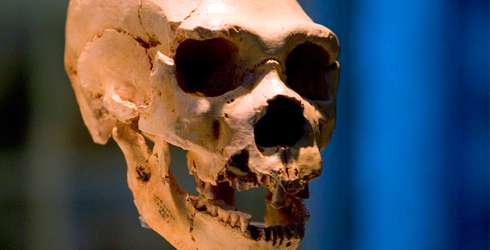Neanderthals may have made a meal of animal stomachs

(Phys.org) —Plant material found on Neanderthal teeth suggests they had a better understanding of their food than previously thought.
In a new article published in the journal Quaternary Science Reviews, Museum anthropologists Laura Buck and Prof Chris Stringer propose that evidence of bitter root plants found on Neanderthal teeth may point to a practice of eating the stomach contents of their prey.
Previous research has suggested that the presence of bitter and nutritionally-poor camomile and yarrow residue on the plaque of 50,000-year-old Neanderthal teeth hints at plants being consumed for medicinal purposes. Buck and Stringer have put forward a different theory.
They suggest instead that the plant compounds could be from the part-digested stomach contents (chyme) of hunted animals.
Nutritious meal
This is a practice still carried out by many cultures, including Australian Aborigines, who eat the chyme of kangaroo, and Greenland Inuit who consume the stomachs of reindeer as a delicacy.
Arctic explorer Fridtjof Nansen in 1893 described reindeer as 'gourmets', living off 'the finest moss and grasses'.
In harsh conditions, such as desert or tundra, eating animal stomach contents allows people to gain nutrients from plants they could not easily obtain otherwise.
Nansen described how reindeer stomach was a prized delicacy for the Inuit: 'The last thing an Eskimo lady enjoins upon her lover, when he sets off reindeer-hunting, is that he must reserve for her the stomach of his prey.'
Drawing parallels with these cultures, Buck and Stringer looked back at the original plaque research and determined that the plant material could well have come from eating animal stomachs.
Sophisticated eating
Neanderthals have long been thought of as pure big game hunters, largely ignoring vegetables and small game, a factor which, it is argued, could have led to their extinction.
But new evidence from tooth plaque and other dietary analyses shows they did eat vegetation, including some types that required complex preparation.
Buck said that consuming yarrow and camomile could have been both for medicine and nutrition, in different times and places, but that either reason suggests Neanderthals had a more diverse diet and better understanding of food in their environment.
'It shows a level of dietary complexity not always appreciated before,' she said.
While some modern cultures consume animal chyme for ritual purposes, and the possibility of ritual behaviour has been suggested for other Neanderthal finds, Stringer said this is not indicated in their research and that nutrition is a simpler explanation.
'Having gone to the time and trouble of securing the carcass of a large herbivore, why would our ancestors have wasted such a source of nutrition?' said Stringer.
Visitors can learn more about Prof Chris Stringer's human origins research and see rare specimens, including Neanderthal skulls, in our new exhibition, Britain: One Million Years of the Human Story, opening February 2014.
Journal information: Quaternary Science Reviews
Provided by Natural History Museum



















